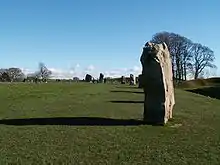Ritual landscape
Ritual landscapes are extensive archaeological tracts that were seemingly dedicated to ceremonial purposes in the Neolithic and early Bronze Ages (c. 3500-1800 BC). The term emerged in the early 1980s in British archaeology and was contrasted with more conventional studies of monument sites concerned with dating, classification, and political divisions. These landscapes are often associated with origin myths, ancestors, homes of spiritual essences, or locales where mythical or historical events occurred while the landscape features include social memory and the preservation of the myths, histories, trusts, and the belongings of a people.[1] Aside from a place of origin and mythology, ritual landscapes were also considered places of protection and renewal.[1][2]

Features
Many ritual landscapes were gradually built around the two earliest classes of Neolithic communal monuments, known as long barrows and causewayed enclosures.[3] In Britain, for instance, the Avebury ritual site featured a giant, flat-topped barrow called Silbury Hill, which is considered the largest artificial mound in prehistoric Europe.[4] The evidence of contemporary settlement within these landscapes is often sparse or absent altogether; conversely, non-utilitarian structures and artifacts are typically abundant.[5] In other cultures, the ritual landscape is strongly influenced by the environment. This is demonstrated in the case of Tibet, the verticality of the environment dominated the constructions of the ritual landscape and features therein such as structures and tombs, which were built to resemble the mountains.[6]
Ritual landscapes went out of use relatively abruptly around 1500 BC and were replaced by smaller-scale shrines, which were often located near rivers, marshes, and springs. These smaller shrines usually feature offerings of food and metalwork and continued to be created and used into Roman and even Saxon times. Today they are often described as Celtic.[3]
References
- Palka, Joel (2014). Maya Pilgrimage to Ritual Landscapes: Insights from Archaeology, History, and Ethnography. Albuquerque, NM: University of New Mexico. p. 101. ISBN 9780826354747.
- Tate, Carolyn (2012). Reconsidering Olmec Visual Culture: The Unborn, Women, and Creation. Austin, TX: University of Texas Press. p. 16. ISBN 9780292728523.
- Pryor, Francis (1 December 2015). "Ritual Landscapes by Francis Pryor". The London Magazine. Retrieved 6 September 2017.
- Silberman, Neil Asher (2012). The Oxford Companion to Archaeology, 2nd edition. New York: Oxford University Press. p. 169. ISBN 9780199735785.
- Robba, John G. (24 Feb 2007), "The 'ritual landscape' concept in archaeology: a heritage construction", Landscape Research, 23 (2): 159–174, doi:10.1080/01426399808706533
- Insoll, Timothy (2011). he Oxford Handbook of the Archaeology of Ritual and Religion. Oxford: Oxford University Press. p. 29. ISBN 9780199232444.
